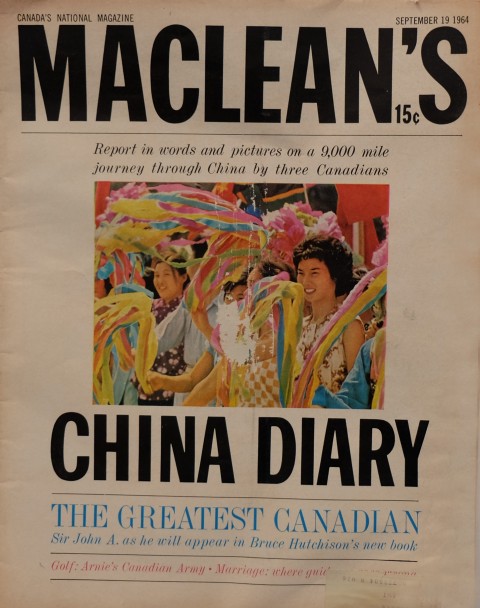
It was 50 years ago this week that the earliest article I know of on Canadian WECA comics appeared in the Sept. 19, 1964 issue of Maclean’s Magazine. It was written by Alexander (“Sandy”) Cameron Ross as part of a series called “A Maclean’s Flashback” and its title was “A Fond Portrait of those Wild Wartime Comics.” Ross was perhaps best known for founding Canadian Business magazine in 1977 and posthumously has had a national award ‘The Alexander Ross Award for Best New Writer’ given out by the National Magazines Awards Foundation.
This piece was done twenty years after the time of these comics; yet remember how early it still was. This was just about six months before Governor General Vanier and Prime Minister Pearson lowered the Red Ensign on Parliament Hill and raised our new Canadian Maple Leaf flag. It was three years before our grand Centennial celebrations and the showcasing of Canada to the rest of the world at Expo 67 and a full eight years before that galvanizing 1972 Hockey Summit. Canada grew so much in those short years and has grown taller since.
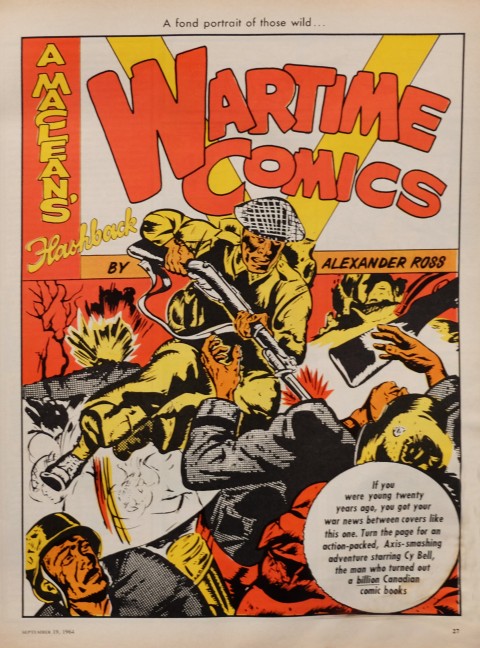
Ross, born in 1935, probably knew the later WECA books best and wasn’t yet thirty himself when he wrote this article. It is almost exclusively an interview with Cy Bell, though a large graphic on the first text page reprints a four page story about Donald Gordon from a Canadian Heroes comic that was published by Educational Projects out of Montreal. In this way, it foreshadows the same general misconception that was the underpinning of the first hardbound volume on Canadian wartime comics over half-a-dozen years later and this was Hirsh and Loubert’s The Great Canadian Comic Books (Peter Martin, 1971). This misconceived presupposition was that Toronto’s Bell Features were the beginning and end of Canadian war-time comics in Canada.
Another Ross, Ted Ross, must not have seen the 1964 article, but he did respond to Maclean’s Nov. 8, 1971 article on the release of the Hirsh-Loubert book with a brief but scathing note bringing attention to this.
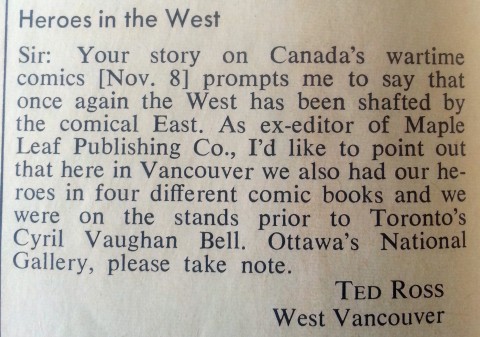
One of the central points that Ross makes is that even though the production values of these Bell Features comics wasn’t generally that great (in terms of writing and art), the characters and stories became embedded in the psyches of those kids who grew up with them. This was the shiny side of the dime, the dull side, however, was that anybody outside this window really didn’t know much about them at all.
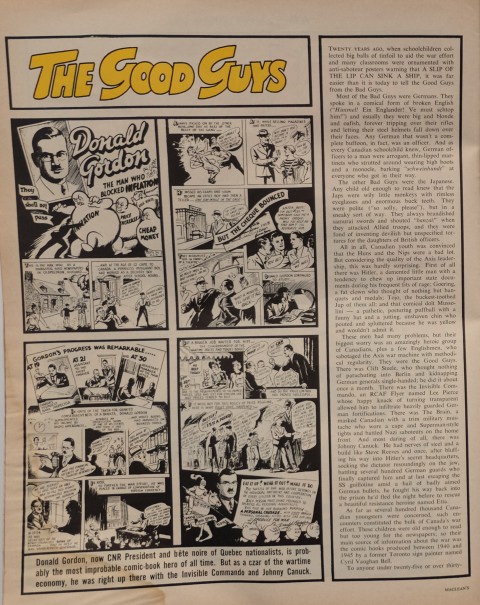
Ross informs us that the whole Bell Features comic book enterprise began when one of Cy Bell’s young sign painters, Edmund Legault, approached him with a few finished stories that he’d done about a swashbuckling, 18th century character he had created called Dart Daring. With the comic book field fairly wide open without the presence of American comics in Canada, Bell decided to jump in and Legault became the central writer and artist for a comic book called Wow Comics which had a first issue cover date of September, 1941. He also tells us that by the war’s end, Cy Bell’s presses were bigger than the Toronto Star’s, that Bell was employing over 60 artists, and that the company was producing over a hundred thousand comics a week.
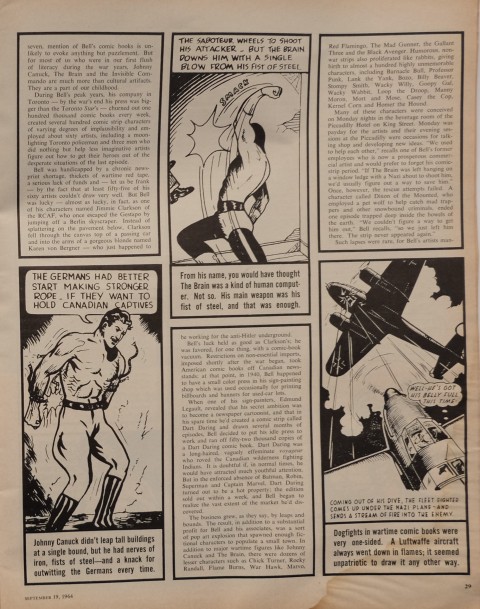
From looking at the Cy Bell papers up at the Library and Archives of Canada in Ottawa, I was most impressed with the constant struggle he was having finding enough newsprint to produce the number of comics he wanted to put out and the fight for full four-colour printing presses that could create comics that could rival the impending tidal wave comics that would flood into Canada once we took our thumbs out of the political dyke that was holding them back.
Cy Bell went on to purchase and operate a large resort hotel in Crystal Beach after he turned over his comic business to his brother in the late forties. He was still running the hotel at the time the article was written.
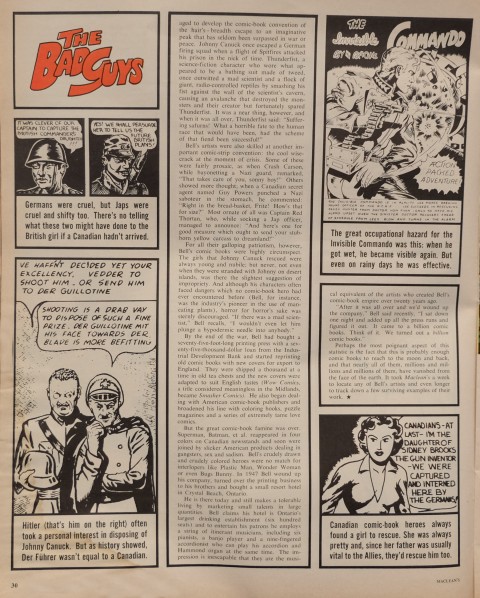
Towards the end of the article, Ross quotes Cy Bell as saying the following: “After it was all over and we’d wound up the company… I sat down one night and added up the press runs and figured it out. It came to a billion comic books. Think of it. We turned out a billion comic books.”
For me, Ross makes his most telling comment at the close of his article. Here he says that even though Bell put out a billion comic books “…nearly all of them, millions and millions and millions of them, have vanished from the face of the earth. It took Maclean’s a week to locate any of Bell’s artists and even longer to track down a few surviving examples of their work.” If they were that scarce already by 1964 when Silver Age Marvel was hitting its stride, what hope do we have of finding significant collections of them now?
——–
On Saturday coming (Sept. 20), Cy Bell will be one of two (the other will be Edmond Good) Canadian Golden Age honorees inducted into the Canadian Comic Book Creator Hall of Fame at the 2014 Joe Shuster Awards presentation ceremony. This will take place at Back Space Toronto, 587A College St. (2nd floor), Toronto. This will be a great night if you can make it out. The ceremony begins at 8:30 PM. I’ll report on it in next week’s installment.

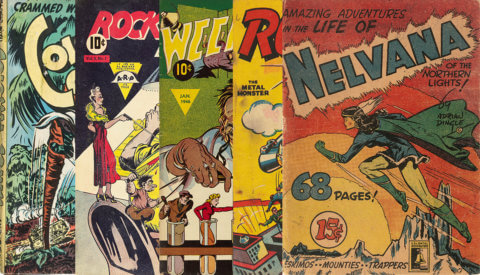
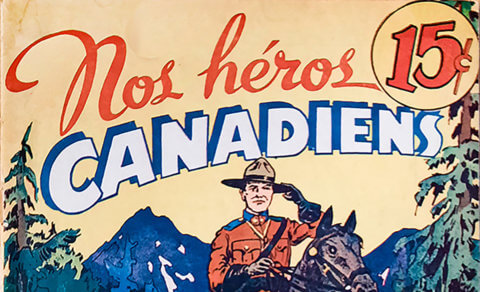
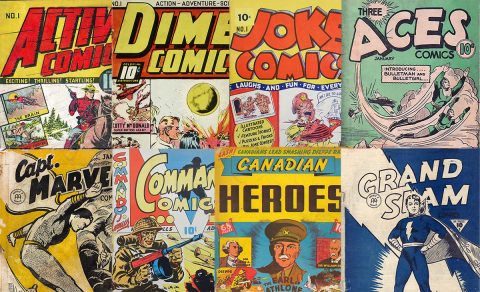
Interesting, as usual. MacLean’s rings a faint bell. I wonder if I saw a later article on Marvel or something. I wish my old zines were organized enough to lay my hands on it.
What I still don’t understand: besides the smaller print runs, what is unique to WECA comics that makes them so terribly scarce. Down here we had the paper drives and even burning and the huge scare Wertham brought about, and yet U.S. Comics are for the most part VERY plentiful.
Thanks Bud. I think that something that we need to take into account is the population difference between the US and Canada. During the Years 1941-46 the US population grew from about 130 million to 140 million, so there a lot of kids of the right age available to buy these comics of the rack (let’s say 20 million kids or so). In Canada for the same period the population grew from about 11.5 million to 12.3 million (Canada’s population has always been about 10% or less of the American population) so I’d say there’d only be about 1-1.5 million kids of the right age to buy comics off the rack. So there you have quite a different potential starting base that would first of all be bought and then only a small percentage of that which, after the attrition of natural damage and disposal by parents and kids themselves when they matured, were collected and preserved over more than seven decades. This, I think, is the biggest factor that contributes to the rarity of these comics.
This Wartime Comics article and other things like the recent reprint book(s), older comic strip collections possibly ( Doug Wright and Ting come to mind) are just the things we need to put in a physical repository somewhere. I feel we should try to have a comics archive, either a section in the Ontario Archives, or some other suitable place to keep copies available for our particular Canadian history for reference and just general readers who may be interested.
The internet is fine as long as the pages stay up, but what will happen to the information when the website is gone. I don’t see us having a comic book museum in this country any time soon, but possibly we can put together a collection for comics and pulps and reference books in some friendly place with public access. I’d love to see some ideas on this.
You might be thinking of another Maclean’s article by writer A. Ross from a March (19th?) 1966 issue Bud. It was titled “Return of the Old Invincibles” and featured at least Batman and Superman, I’m not sure about any Marvels though.
You’re so right, Jim. I’m glad you brought this up. The whole reason I am doing any of this is that I’d like to work against it being lost and forgotten. It’s such a beautiful and integral part of our culture and it would be a shame if it should get remaindered and knowledge of it eventually disappear. All the history books, psychological look backs, and sociological archaeology don’t capture how important the popular music and comic books were for the kids of the time. We shouldn’t lose the importance of these wartime comics to the youth culture of the time and to our Canadian culture in general.
I don’t know how we would go about finding the proper repository for all of this stuff. Maybe it needs to be a giant kickstarter? I know, for example, that Robert MacMillan, who has a huge collection of Canadian popular cultural material (including a good number of Canadian WECA comics) going quite a long way back hasn’t been able to find a university archive that is interested in taking it. Very often, it seems, Canada itself doesn’t recognize some of the things that are central to what makes it Canadian.
Ivan, that’s a great explanation and I appreciate that instead of relying on unknown or mostly unknown WECA print runs, it’s goes with a more reliable comparison of populations. BUT…is that the entire explanation?
Even if you consider every WECA print run to be roughly 10% of a typical U.S. comic, to me the scarcity is still not entirely explained. Could there be any other factors DIFFERENT in Canada–for instance, that had MORE impact on copies saved by kids or destroyed.
Was there the same non-returnable distribution system that gave retailers credit for unsold copies (via affidavite returns or stripped & returned covers or cover logos–thus creating 3/4 cover comics–like in the U.S.)? This would boost print runs, as it did in the U.S., compared to a distribution system that allowed NO credit for returns (unsold copies) where the comics were purchased outright. (i.e. comparing the traditional U.S. distribution system to the Direct Market pioneered by Phil Seuling in the 1970s), where copies were sold non-returnable. Of course the Direct Market put the comics direct into collector’s hands, via comic stores, so the effect was the opposite…MORE copies being preserved. But a different system would not have the same effect, but might instead hold down print runs as everyone in the system (distributor to retailer) doesn’t want to be stuck with unsold copies.
Both countries I assume had wartime paper drives, and the 1950s comic scare that had parents tossing out comics. Were these more pronounced in Canada? Is there any reason, unique to Canada, that would have meant less comics preserved by kids? There are SO many U.S. comics still around, so even if you cut the present day supply by a factor of 10, I wonder if they’d be as scarce as WECA books.
Bud, I wonder if there is something cultural?
Perhaps the continuity of titles like Action, Detective etc lead to a collecting culture developing in the USA before up here.
A certain percentage of kids picking up a comic numbered #107 may have been drawn to start collecting backwards and hunting down old issues.
Perhaps the WECA runs were too short lived for this to take hold?
Also, I’d love to see the data on failed US publications versus successful US publications. In other words are there more 1942 Superman comics saved as a percentage of print run versus say Shield comics?
I don’t have the answers but am suggesting possible subtle influences that over time may have had some impact.
There has never been a 3/4 cover Canadian Comic, either a White or US reprint book that I have ever seen.
A large number of Canadian Whites that attempted 3 or 4 colour were horribly out of register upon printing, along with many of the reprints of US books at that time that were also printed that way and sold ,and even if they didn’t they had poor quality due to the used print mats that were shipped up to Canada to make the books.
That I would think made the biggest impact on whether a kid would want to keep the book and might have contributed the most to the number of surviving copies. Especially during a paper drive discarding them would have been a quick and easy decision someone would make if someone knocked at your door asking for an impromptu donation, much like we throw out newspapers these days.
Why are there still some of the books surviving, even poor quality ones?
Hopefully it was due to patriotic Canadians comic collectors supporting the war effort, regardless, and collectors like me that would include the odd Canadian books along with my shared propensity to collecting long runs of US books.
But I do agree that short run series, for whatever reason, are likely to be considered failures and fully collected small series are more likely to be something to get rid of by a completionist when they become fully collected.
This is turning out to be a great thread. Thanks, Bud. When I went up to the archives a few months ago, I found a couple of sheets in Cy Bell’s papers that had on them the sold figures for a couple of Fawcett titles. These were the sold copies, not the print runs and they were grouped for the last 6 months of 1944 and the first six months of 1945. The recorded copies sold for Capt. Marvel Adventures were 1,221,649 for the last 6 mos. of 44 and 1,235,068 for the first 6 mos. of 45. This title was a monthly so, if we assume that this is for 6 issues each period, we have Cap. M. sending just over 200,000 copies off the stands into the hands of kids. I believe print runs of Canadian books were about 50-60,000 and I would probably assume that they were able to sell about half or so scattered across Canada. So we can start with way fewer copies in the hands of readers. Let me set down a few of the reasons I can think of as to why the disparity in the number of surviving copies on each side of the border (and I don’t think there was a 3/4 cover return policy here in Canada… I’ve never seen a 3/4 cover torn copy of a Canadian book):
1. Fewer copies in the hands of readers.
2. Scarcity of paper and war conservation drives reducing number of surviving copies.
3. Strong campaign, even in the comics themselves, to send read copies overseas to troops.
4. Fewer urban centers where newsstand titles could appear and where a comic book culture could develop. Our major cities are all pretty close to the border and there’s nowhere near the number in the States.
5. The window of these comics was only 6 years long and as soon as it closed the books started to fall off our cultural radar. You had Superman and Batman books all through the fifties and sixties, firmly planting these characters into the psyches of kids who might go around and try to search out back issues and bring them into the fold of surviving copies. Never happened in Canada. Nothing really until Hirsh and Loubert’s Great Canadian Comic Books appeared. None of us growing up in the late fifties and sixties really knew these existed.
6. Canadians have always had difficulty determining who they were and what their identity and culture was all about. It took us a long time to develop a sense of Canadian “coolness” after a long wilderness of walking around with big “?” on our foreheads. We’re just starting to come into our own recently and that’s one of the reasons I think were starting to hold up these issues as totems of who we are. The states never had any trouble knowing who they were and all the Caps, Supermen, and Wonderwomen were part and parcel that.
That’s a few of the reasons why I think you guys have ended up with “golden” books and we’ve ended up with “diamonds.”
You know Walt, trying to figure this out would make a great article. You guys are coming up with great possible reasons.
Yes, a good point, Jim. The best word I can think of to describe the overall published quality of most WECA books, when we compare them with American books of the period, is “quaint”. Visibly impoverished when set along side contemporary American books, yet still having some “magic.” Why would people want to save or go after this inferior product when slick, four color beauties were at hand filled with characters we were way more familiar with?
Thanks for sharing the Macleans article and for the speculation about lack of surviving copies. I think the comparatively low print runs, lacklustre production values, short time span, and combine U.S. cultural imperialism/Canadian inferiority complex all conspired for decades to keep these comics under our collective radar. Not in Overstreet=not real, collectible comics. Thank Koliak for the few hardy collectors who have systematically accumulated the surviving copies of these books and for people like Hope and Rachel for finally reprinting them!
Thanks for your comment, Bryan. I agree wholeheartedly with the points you make. We are just beginning to bring these books back home into our collective cultural psyche and I think that the effort is beginning to pay off. We, and even some American collectors, are starting to see what these books really were.